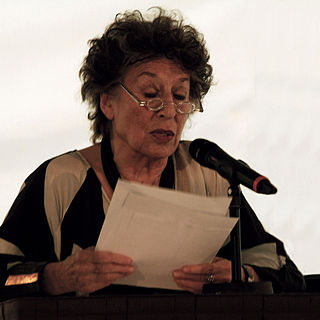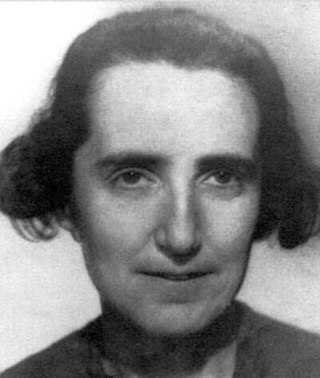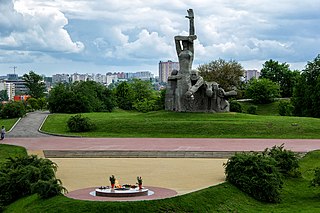
The Memorial to the Murdered Jews of Europe, also known as the Holocaust Memorial, is a memorial in Berlin to the Jewish victims of the Holocaust, designed by architect Peter Eisenman and Buro Happold. It consists of a 1.9-hectare (4.7-acre) site covered with 2,711 concrete slabs or "stelae", arranged in a grid pattern on a sloping field. The original plan was to place nearly 4,000 slabs, but after the recalculation, the number of slabs that could legally fit into the designated areas was 2,711. The stelae are 2.38 m long, 0.95 m wide and vary in height from 0.2 to 4.7 metres. They are organized in rows, 54 of them going north–south, and 87 heading east–west at right angles but set slightly askew. An attached underground "Place of Information" holds the names of approximately 3 million Jewish Holocaust victims, obtained from the Israeli museum Yad Vashem.

Vergangenheitsbewältigung is a German compound noun describing processes that since the later 20th century have become key in the study of post-1945 German literature, society, and culture.

Theresienstadt Ghetto was established by the SS during World War II in the fortress town of Terezín, in the Protectorate of Bohemia and Moravia. Theresienstadt served as a waystation to the extermination camps. Its conditions were deliberately engineered to hasten the death of its prisoners, and the ghetto also served a propaganda role. Unlike other ghettos, the exploitation of forced labor was not economically significant.

Lea Rosh is a German television journalist, publicist, entrepreneur and political activist. Rosh was the first female journalist to manage a public broadcasting service in Germany and in the 1970s the first anchorwoman of Kennzeichen D, a major political television program. She has been a member of the SPD since 1968.

Theresienstadt. Ein Dokumentarfilm aus dem jüdischen Siedlungsgebiet, unofficially Der Führer schenkt den Juden eine Stadt, was a black-and-white projected Nazi propaganda film. It was directed by the German Jewish prisoner Kurt Gerron and the Czech filmmaker Karel Pečený under close SS supervision in the Theresienstadt concentration camp, and edited by Pečený's company, Aktualita. Filmed mostly in the autumn of 1944, it was completed on 28 March 1945 and screened privately four times. After the war, the film was lost but about twenty minutes of footage was later rediscovered in various archives.

The Judenplatz Holocaust Memorial also known as the Nameless Library stands in Judenplatz in the first district of Vienna. It is the central memorial for the Austrian victims of the Holocaust and was designed by British artist Rachel Whiteread.

Cora Berliner was an economist and social scientist and a victim of the Nazi regime. She was a pioneer of social work.

Zmievskaya Balka, Zmiyovskaya Balka is a site in Rostov-on-Don, Russia at which 27,000 Jews and Soviet civilians were massacred in 1942 to 1943 by the SS Einsatzgruppe D during the Holocaust in Russia. It is considered to be the largest single mass murder site of Jews on Russian territory during the Second World War. The name means "the ravine of the snakes".

Gully of Petrushino is a site on the outskirts of Taganrog, Russia, at which 7,000 Soviet civilians, mostly Jews, were massacred between 1941 and 1943 by the German army, with the assistance of non-German divisions, during their occupation of Taganrog.

The Holocaust in Luxembourg refers to the systematic persecution, expulsion and murder of Jews in Luxembourg after its occupation and later annexation by Nazi Germany. It is generally believed that the Jewish population of Luxembourg had numbered around 3,500 before the war although many fled into France at the time of the German invasion of 10 May 1940 or in the early months of the occupation. Around 1,000 to 2,500 were murdered during the Holocaust after being deported to ghettos and extermination camps in Eastern Europe, under the Civil Administration of Gustav Simon.
Israel Alter was an Austrian-Hungarian Jewish cantor and last chief cantor in Hanover, Germany. The well traveled composer was regarded as "the one Chasanim, the cantor of the cantors".

Nandor Glid was a Yugoslav sculptor, best known for designing the memorial sculpture at the Dachau concentration camp.
Siegbert Einstein was a German-Jewish politician, factory worker, civil servant, lawyer, Holocaust survivor, and the last Jew who lived in the Jewish community in Bad Buchau.

The Theresienstadt family camp, also known as the Czech family camp, consisted of a group of Jewish inmates from the Theresienstadt ghetto in Czechoslovakia, who were held in the BIIb section of the Auschwitz II-Birkenau concentration camp from 8 September 1943 to 12 July 1944. The Germans created the camp to mislead the outside world about the Final Solution.
During World War II, the Theresienstadt Ghetto was used by the Nazi SS as a "model ghetto" for deceiving International Committee of the Red Cross representatives about the ongoing Holocaust and the Nazi plan to murder all Jews. The Nazified German Red Cross visited the ghetto in 1943 and filed the only accurate report on the ghetto, describing overcrowding and undernourishment. In 1944, the ghetto was "beautified" in preparation for a delegation from the International Committee of the Red Cross (ICRC) and the Danish government. The delegation visited on 23 June; ICRC delegate Maurice Rossel wrote a favorable report on the ghetto and claimed that no one was deported from Theresienstadt. In April 1945, another ICRC delegation was allowed to visit the ghetto; despite the contemporaneous liberation of other concentration camps, it continued to repeat Rossel's erroneous findings. The SS turned over the ghetto to the ICRC on 2 May, several days before the end of the war.

The memorial against war and fascism is a work by the Austrian sculptor Alfred Hrdlicka. It has been standing since 1988 on the Albertinaplatz in Vienna – named after Helmut Zilk in 2009 – opposite the Palais Archduke Albrecht and the back of the Vienna State Opera. As a walk-in monument, it is intended to serve as a reminder of the darkest epoch in Austrian history. It is dedicated to all victims of war and fascism.
The history of the Jews in Hannover began in the 13th century. In 2009, about 6200 people belonged to the four Jewish communities in Hannover.
The Gedenkbuch – Opfer der Verfolgung der Juden unter der nationalsozialistischen Gewaltherrschaft 1933–1945 is a memorial book published by the German Federal Archives, listing persons murdered during the Holocaust as part of the Nazis' so-called "Final Solution". It is limited to people, regardless of nationality, who voluntarily lived within the borders of the German Reich as of December 31, 1937. Since 2007, it has been available online. As of February 2020, it contained 176,475 names. Alongside the Arolsen Archives and Yad Vashem's central database, it is considered an important resource for Holocaust research. Since its publication, many cities and states have published their own memorial books, complementing and expanding on the Gedenkbuch.
















